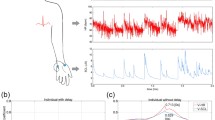Abstract
The cardiac-somatic coupling hypothesis predicts a phasic decrease of general somatic behavior concomitant with a phasic heart-rate deceleration. This hypothesis was investigated during a constant 4 s foreperiod (FP) in a simple auditory reaction-time task. Intertrial interval duration was variable (mean 15.5 s; range 11–20 s). The response was a plantar flexion of the right foot. Besides ECG and EOG, surface EMG of nine striate muscles varying in relevance to response execution was recorded.
In agreement with the hypothesis, heart rate, eye movements, and m. mylohyoideus EMG were decreased at the end of the FP. An increase in the EMG of the agonist m. soleus, antagonist m. tibialis anterior, m. peroneus longus, and m. trapezius was found during the FP. The activity in all other response-irrelevant muscles did not significantly differ from baseline. It was concluded that the results are at variance with the cardiac-somatic coupling hypothesis. Changes in surface EMG are discussed in terms of motor preparation.
Similar content being viewed by others
References
Bouisset S., & Zattara M. (1981). A sequence of postural movements precedes voluntary movement. Neuroscience Letters, 22 263–270.
Brunia C.H.M., & Vingerhoets A.J.J.M. (1980). CNV and EMG preceding a plantar flexion of the foot. Biological Psychology, 11 181–191.
Cohen M.J., Johnson H.J., & McArthur D.L. (1980). Interaction of a motor response, and reaction time and time estimation tasks, on heart rate and skin conductance. Psychophysiology, 17 377–384.
Coles M.G., & Duncan-Johnson C.C. (1975). Cardiac activity and information processing: the effects of stimulus significance, and detection and response requirements. Journal of Experimental Psychology: Human Perception and Performance, 1 418–428.
Damato A.N., Galante J.G., & Smith W.M. (1966). Hemodynamic response to tread-mill exercise in normal subjects. Journal of Applied Physiology, 21 959–966.
Gahery Y., & Massion J. (1981). Co-ordination between posture and movement. Trends in Neurosciences, 4 199–202.
Gottsdanker R. (1975). The attaining and maintaining of preparation. In: P. Rabbitt and S. Dornic (Eds.) Attention and Performance. V. London: Academic Press, 33–49.
Graham F.K. (1978). Constraints on measuring heart rate and period sequentially through real and cardiac time. Psychophysiology, 15 492–495.
Guyton A.C. (1981). Textbook of Medical Physiology. Philadelphia: W.B. Saunders Company, 232–245.
Haagh S.A.V.M., Spoeltman W.T.E., Scheirs J.G.M., & Brunia C.H.M. (1983). Surface EMG and Achilles tendon reflexes during a foot movement in a reaction time task. Biological Psychology, 17 81–96.
Lacey J.I., & Lacey B.C. (1970). Some autonomic-central nervous system interrelationships. In: P. Black (Ed.) Physiological Correlates of Emotion. New York: Academic Press, 205–228.
Näätänen R., & Merisalo A. (1977). Expectancy and preparation in simple reaction time. In: S. Dornic (Ed.) Attention and Performance VI. Hillsdale, NJ: Erlbaum, 115–138.
Nashner L.M., & Cordo P.J. (1981). Relation of automatic postural responses and reaction-time voluntary movements of human leg muscles. Experimental Brain Research, 43 395–405.
Niemi P., & Näätänen R. (1981). Foreperiod and simple reaction time. Psychological Bulletin, 89 133–162.
Obrist P.A. (1968). Heart rate and somatic-motor coupling during classical aversive conditioning in humans. Journal of Experimental Psychology, 77 180–193.
Obrist P.A., Howard J.L., Sutterer J.R., Sterling Hennis R., & Murrell D.J. (1973). Cardiac-somatic changes during a simple reaction time task: a developmental study. Journal of Experimental Child Psychology, 16 346–362.
Obrist P.A., Webb R.A., & Sutterer J.R. (1969). Heart rate and somatic changes during aversive conditioning and a simple reaction time task. Psychophysiology, 5 696–723.
Obrist P.A., Webb R.A., Sutterer J.R., & Howard J.L. (1970a). The cardiac-somatic relationship: some reformulations. Psychophysiology, 6 569–587.
Obrist P.A., Webb R.A., Sutterer J.R., & Howard J.L. (1970b). Cardiac deceleration and reaction time: an evaluation of two hypotheses. Psychophysiology, 6 695–706.
Sanders A.F. (1980). Some effects of instructed muscle tension on choice reaction time and movement time. In: S. Nickerson (Ed.) Attention and Performance VIII. Hillsdale, NJ: Erlbaum, 59–75.
Simons R.F., Öhman A., & Lang P.J. (1979). Anticipation and response set: cortical, cardiac, and electrodermal correlates. Psychophysiology, 16 222–233.
Taniguchi R., Nakamura R., Yokochi F, & Narabayashi H. (1980). Effects of postural change of the shoulder on EMG Reaction Time of triceps brachii. Applied Neurophysiology, 43 40–47.
Webb R.A., & Obrist P.A. (1970). The physiological concomitants of reaction time performance as a function of preparatory interval and preparatory interval series. Psychophysiology, 6 389–403.
Winer B.J. (1971). Statistical Principles in Experimental Design. Tokyo: McGraw-Hill Inc.
Author information
Authors and Affiliations
Rights and permissions
About this article
Cite this article
Haagh, S.A.V.M., Brunia, C.H.M. Cardiac-somatic coupling during the foreperiod in a simple reaction-time task. Psychol. Res 46, 3–13 (1984). https://doi.org/10.1007/BF00308589
Issue Date:
DOI: https://doi.org/10.1007/BF00308589




